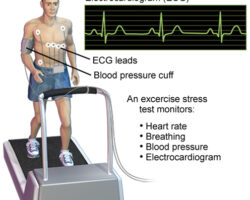The heart’s reaction to stress is measured via a treadmill test phase. Exercise stress testing is another name for it. This is usually the first stress test that indicated if the person can walk and has a normal ECG. The client walks on a treadmill while being monitored to see how far he or she can walk and whether any chest discomfort or ECG abnormalities indicate that the heart muscle is not receiving enough blood.
Stress Test
Stress Test Treatment in Nashik - Asha Heart Clinic
Treadmill Stress Test

How does a stress test work?
The first step in a cardiac stress test is to make your heart beat faster and harder. Many individuals do this by stepping on a treadmill or cycling on a stationary bike. This is why the exam is commonly referred to as an exercise stress test.
Your reaction to the increased workload is measured by healthcare professionals.:
• Blood pressure.
• Heart rate.
• Oxygen levels.
• Electrical movement in your heart.
• In comparison to others your age and gender, how tough your heart is functioning.
Why do an exercise stress test?
An incremental exercise test is generally used to assist your doctor in determining if your heart gets sufficient oxygen and sufficient blood flow where it’s most needed, such as during exercise.
People who are suffering chest pains or other signs of cardiovascular disease might have it done (also called coronary artery disease).
An exercise testing procedure may also be used to assess your health, especially if you’re setting up a new exercise regimen. This helps your doctors to figure out how much activity you can undertake safely.
Why might I need a stress test?
This test may be required to diagnose cardiac issues including as:
- Congenital heart disease.
- Congestive heart failure.
- Coronary artery disease.
- Heart valve disease.
- Hypertrophic cardiomyopathy.
Stress testing may also be required for those who work in high-risk jobs (such as pilots or professional sports).
What are the different types of stress tests?
There are a variety of ways to measure heart function when it is working hard. Your heart rate, hypertension, oxygen levels, and electrical impulses are all measured during a cardiac stress test. However, there are some distinctions.
1) Exercise stress test
2)Exercise stress echocardiogram
3)Nuclear stress test
4)Cardiac rehabilitation stress test
How long is a stress test?
The exercise phase of a basic stress test lasts around 10 to 15 minutes. Preparing for exercise and recuperating afterward necessitates extra time.
Stress tests that include cardiology, nuclear imaging, or MRI are usually more time-consuming and may need you to spend up to three hours inside the pressure lab.
Is cardiac stress testing safe?
Exercise stress tests are safe when there are no contraindications. Complications affect just a small percentage of persons. In the unlikely event that you experience an issue, trained healthcare specialists, usually an athletic trainer and cardiology, are present during the test.
Throughout the exams, they evaluate your behavior, data, and symptoms, and if necessary, they give emergency treatment. If you get concerned or uncomfortable during the stress test, you can stop it at any point.
How do I prepare for a stress test?
To prepare, you should:-
• In the hours coming up to the test, don’t consume anything. You might not be allowed to eat till after your nuclear stress test if you’re undergoing one.
• Caffeine should be avoided 24/7 before the test. Caffeine, tea, sports drinks, and several over-the-counter drugs fall under this category.
• Never use tobacco or vape.
• On the day of your testing, you should stop using certain prescription drugs. When you stop taking any drugs, talk to your doctor.
• Try to relax.
• Wear decent, light-weight clothing and good walking shoes.
What happens after the heart stress test?
After you’ve finished or stopped the test, your sensations, pulse rate, blood pressure, and ECG will be monitored until they return to normal. It takes roughly 15 minutes to do this task. You can return home after your heart rate has stabilized.
